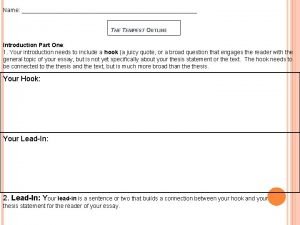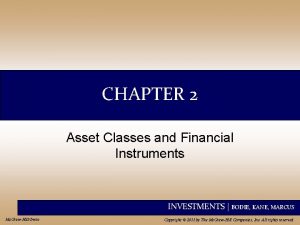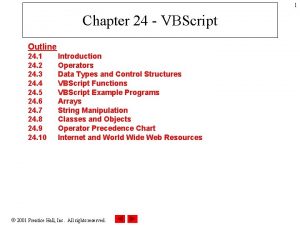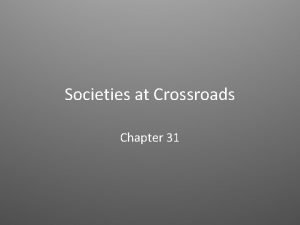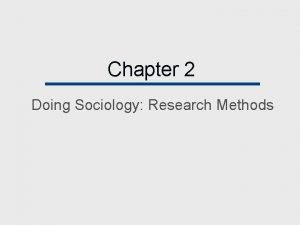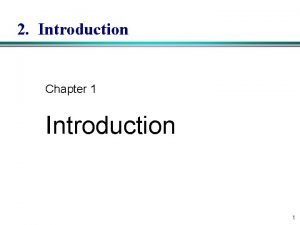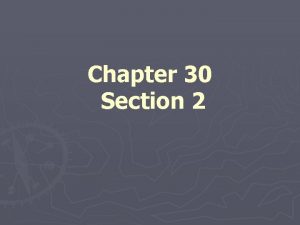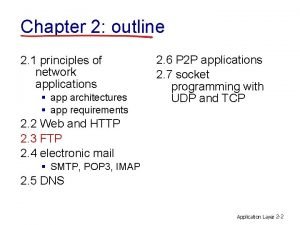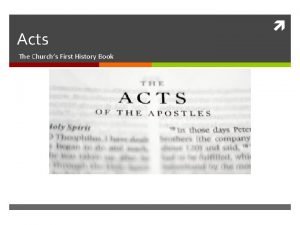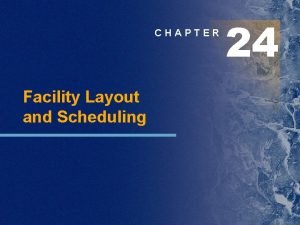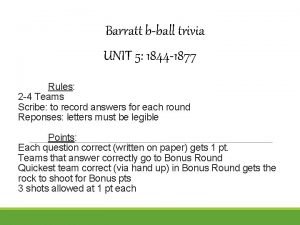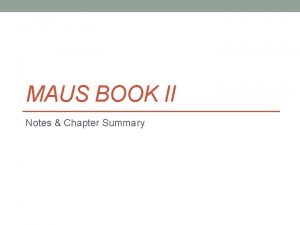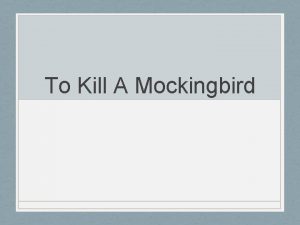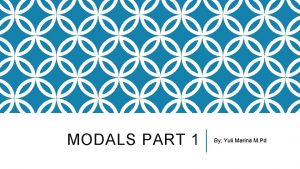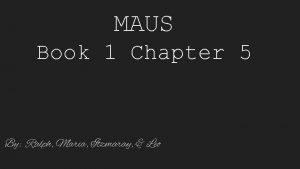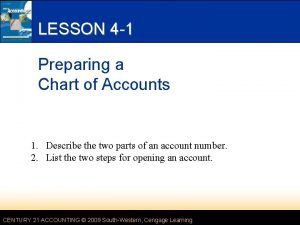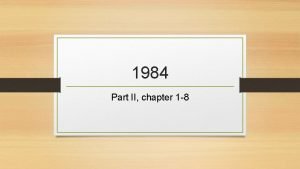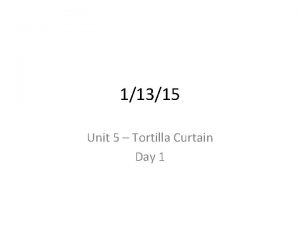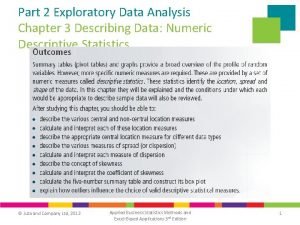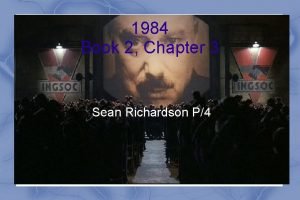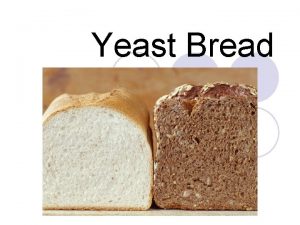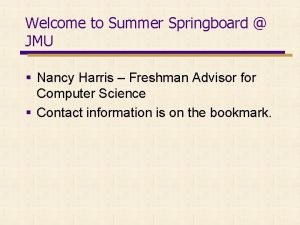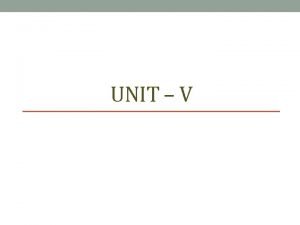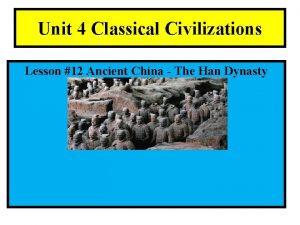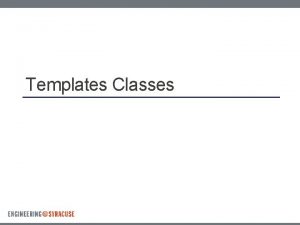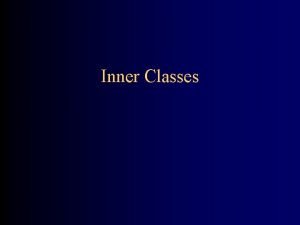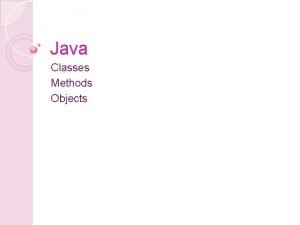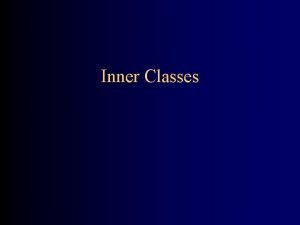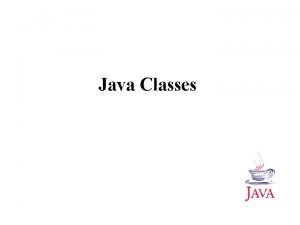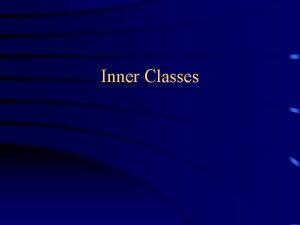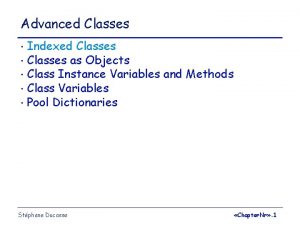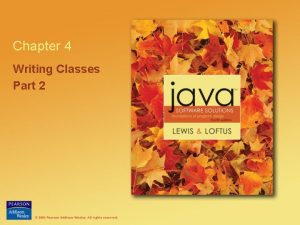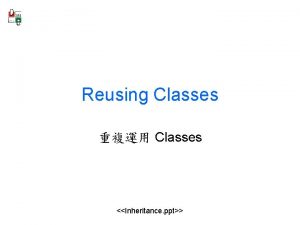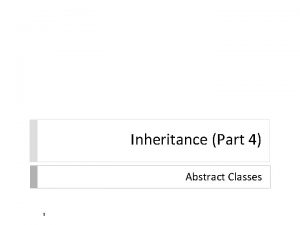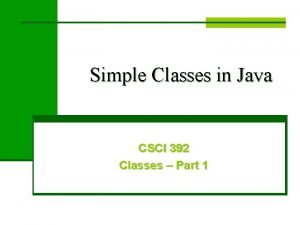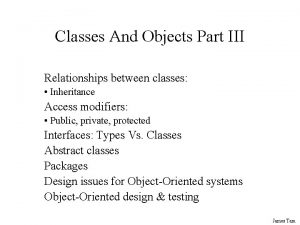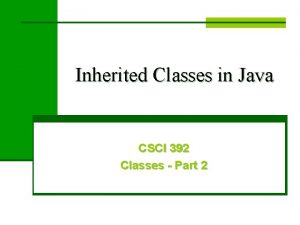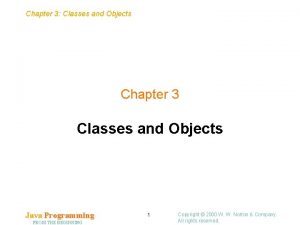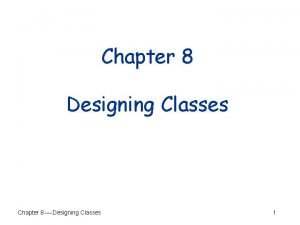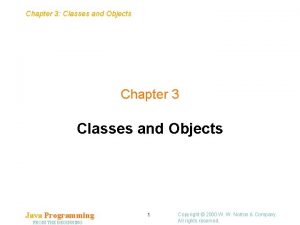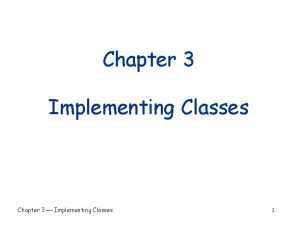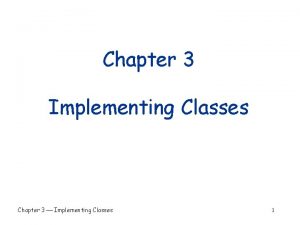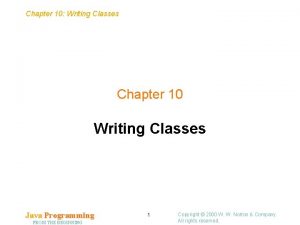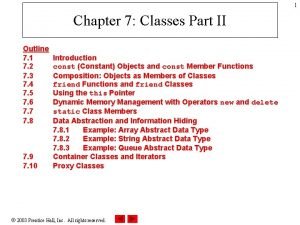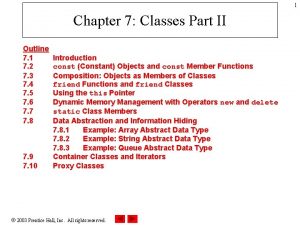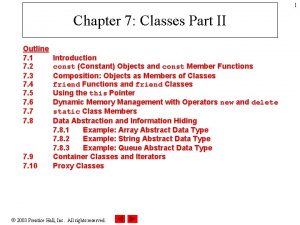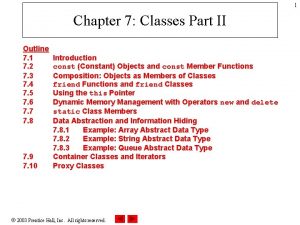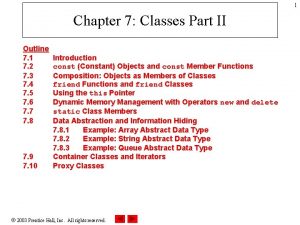Chapter 17 C Classes Part II Outline 17




























































- Slides: 60

Chapter 17 - C++ Classes: Part II Outline 17. 1 17. 2 17. 3 17. 4 17. 5 17. 6 17. 7 17. 8. 1 17. 8. 2 17. 8. 3 17. 9 Introduction const (Constant) Objects and const Member Functions Composition: Objects as Members of Classes friend Functions and friend Classes Using the this Pointer Dynamic Memory Allocation with Operators new and delete static Class Members Data Abstraction and Information Hiding Example: Array Abstract Data Type Example: String Abstract Data Type Example: Queue Abstract Data Type Container Classes and Iterators © Copyright 1992– 2004 by Deitel & Associates, Inc. and Pearson Education Inc. All Rights Reserved. 1

Objectives • In this chapter, you will learn: – To be able to create and destroy objects dynamically. – To be able to specify const (constant) objects and const member functions. – To understand the purpose of friend functions and friend classes. – To understand how to use static data members and member functions. – To understand the concept of a container class. – To understand the notion of iterator classes that walk through the elements of container classes. – To understand the use of the this pointer. © Copyright 1992– 2004 by Deitel & Associates, Inc. and Pearson Education Inc. All Rights Reserved. 2

17. 1 Introduction • Chapters 16 -18 – Object-based programming • Chapter 19 -20 – Polymorphism and inheritance – Object-oriented programming © Copyright 1992– 2004 by Deitel & Associates, Inc. and Pearson Education Inc. All Rights Reserved. 3

17. 2 const (Constant) Objects and const Member Functions • Principle of least privilege • Only give objects permissions they need, no more • Keyword const • Specify that an object is not modifiable • Any attempt to modify the object is a syntax error • For example: const time noon( 12, 0, 0 ); • Defines a const object noon of class time and initializes it to 12 noon © Copyright 1992– 2004 by Deitel & Associates, Inc. and Pearson Education Inc. All Rights Reserved. 4

17. 2 const (Constant) Objects and const Member Functions (II) • const objects require const functions – Functions declared const cannot modify the object – const specified in function prototype and definition Prototype: Return. Type Function. Name(param 1, param 2…) const; Definition: Return. Type Function. Name(param 1, param 2…) const { …}; Example: int A: : get. Value() const {return private. Data. Member}; - Returns the value of a data member, and is appropriately declared const - Constructors / Destructors cannot be const - They need to initialize variables (therefore modifying them) © Copyright 1992– 2004 by Deitel & Associates, Inc. and Pearson Education Inc. All Rights Reserved. 5

Outline times. h (Part 1 of 2) © Copyright 1992– 2004 by Deitel & Associates, Inc. and Pearson Education Inc. All Rights Reserved. 6

Outline time. h (Part 2 of 2) time 5. h (Part 1 of 3) © Copyright 1992– 2004 by Deitel & Associates, Inc. and Pearson Education Inc. All Rights Reserved. 7

Outline time 5. h (Part 2 of 3) © Copyright 1992– 2004 by Deitel & Associates, Inc. and Pearson Education Inc. All Rights Reserved. 8

Outline time 5. h (Part 3 of 3) © Copyright 1992– 2004 by Deitel & Associates, Inc. and Pearson Education Inc. All Rights Reserved. 9

Outline fig 17_01. cpp © Copyright 1992– 2004 by Deitel & Associates, Inc. and Pearson Education Inc. All Rights Reserved. 10

Compiling. . . Fig 17_01. cpp d: fig 17_01. cpp(14) : error C 2662: 'set. Hour' : cannot convert 'this' pointer from 'const class Time' to 'class Time &' Conversion loses qualifiers d: fig 17_01. cpp(20) : error C 2662: 'print. Standard' : cannot convert 'this' pointer from 'const class Time' to 'class Time &' Conversion loses qualifiers Time 5. cpp Error executing cl. exe. Outline Program Output test. exe - 2 error(s), 0 warning(s) © Copyright 1992– 2004 by Deitel & Associates, Inc. and Pearson Education Inc. All Rights Reserved. 11

17. 2 const (Constant) Objects and const Member Functions (III) • Member initializer syntax • Data member increment in class Increment. • Constructor for Increment is modified as follows: Increment: : Increment( int c, int i ) : increment( i ) { count = c; } • ": increment( i )" initializes increment to the value of i. • Any data member can be initialized using member initializer syntax • consts and references must be initialized this way • Multiple member initializers • Use comma-separated list after the colon © Copyright 1992– 2004 by Deitel & Associates, Inc. and Pearson Education Inc. All Rights Reserved. 12

Outline fig 17_02. cpp (Part 1 of 2) © Copyright 1992– 2004 by Deitel & Associates, Inc. and Pearson Education Inc. All Rights Reserved. 13

Outline fig 17_02. cpp (Part 2 of 2) Before incrementing: count After increment 1: count = After increment 2: count = After increment 3: count = = 10, increment 15, increment = 20, increment = 25, increment = = 5 5 © Copyright 1992– 2004 by Deitel & Associates, Inc. and Pearson Education Inc. All Rights Reserved. Program Output 14

Outline fig 17_03. cpp (Part 1 of 2) © Copyright 1992– 2004 by Deitel & Associates, Inc. and Pearson Education Inc. All Rights Reserved. 15

Outline fig 17_03. cpp (Part 1 of 2) © Copyright 1992– 2004 by Deitel & Associates, Inc. and Pearson Education Inc. All Rights Reserved. 16

Compiling. . . Fig 17_03. cpp D: Fig 17_03. cpp(21) : error C 2758: 'increment' : must be initialized in constructor base/member initializer list D: Fig 17_03. cpp(16) : see declaration of 'increment' D: Fig 17_03. cpp(23) : error C 2166: l-value specifies const object Error executing cl. exe. Outline Program Output test. exe - 2 error(s), 0 warning(s) © Copyright 1992– 2004 by Deitel & Associates, Inc. and Pearson Education Inc. All Rights Reserved. 17

17. 3 Composition: Objects as Members of Classes • Composition • Class has objects of other classes as members • Construction of objects • Member objects constructed in order declared • Not in order of constructor’s member initializer list • Constructed before their enclosing class objects (host objects) • Constructors called inside out • Destructors called outside in © Copyright 1992– 2004 by Deitel & Associates, Inc. and Pearson Education Inc. All Rights Reserved. 18

17. 3 Composition: Objects as Members of Classes (II) • Example: Employee: : Employee( char *fname, char *lname, int bmonth, int bday, int byear, int hmonth, int hday, int hyear ) : birth. Date( bmonth, bday, byear ), hire. Date( hmonth, hday, hyear ) – Insert objects from Date class (birth. Date and hire. Date) into Employee class – birth. Date and hire. Date have member initializers - they are probably consts in the Employee class © Copyright 1992– 2004 by Deitel & Associates, Inc. and Pearson Education Inc. All Rights Reserved. 19

Outline date 1. h © Copyright 1992– 2004 by Deitel & Associates, Inc. and Pearson Education Inc. All Rights Reserved. 20

Outline date 1. cpp (Part 1 of 3) © Copyright 1992– 2004 by Deitel & Associates, Inc. and Pearson Education Inc. All Rights Reserved. 21

Outline date 1. cpp (Part 2 of 3) © Copyright 1992– 2004 by Deitel & Associates, Inc. and Pearson Education Inc. All Rights Reserved. 22

Outline date 1. cpp (Part 3 of 3) © Copyright 1992– 2004 by Deitel & Associates, Inc. and Pearson Education Inc. All Rights Reserved. 23

Outline emply 1. h © Copyright 1992– 2004 by Deitel & Associates, Inc. and Pearson Education Inc. All Rights Reserved. 24

Outline emply 1. cpp (Part 1 of 2) © Copyright 1992– 2004 by Deitel & Associates, Inc. and Pearson Education Inc. All Rights Reserved. 25

Outline emply 1. cpp (Part 2 of 2) © Copyright 1992– 2004 by Deitel & Associates, Inc. and Pearson Education Inc. All Rights Reserved. 26

Outline fig 17_04. cpp © Copyright 1992– 2004 by Deitel & Associates, Inc. and Pearson Education Inc. All Rights Reserved. 27

Date object constructor for date 7/24/1949 Date object constructor for date 3/12/1988 Employee object constructor: Bob Jones, Bob Hired: 3/12/1988 Birth date: 7/24/1949 Outline Program Output Test Date constructor with invalid values: Month 14 invalid. Set to month 1. Day 35 invalid. Set to day 1. Date object constructor for date 1/1/1994 Date object destructor for date 1/1/1994 Employee object destructor: Jones, Bob Date object destructor for date 3/12/1988 Date object destructor for date 7/24/1949 © Copyright 1992– 2004 by Deitel & Associates, Inc. and Pearson Education Inc. All Rights Reserved. 28

17. 4 friend Functions and friend Classes – friend function and friend classes – Can access private and protected (more later) members of another class – friend functions are not member functions of class – Defined outside of class scope – Properties – Friendship is granted, not taken – NOT symmetric (if B a friend of A, A not necessarily a friend of B) – NOT transitive (if A a friend of B, B a friend of C, A not necessarily a friend of C) © Copyright 1992– 2004 by Deitel & Associates, Inc. and Pearson Education Inc. All Rights Reserved. 29

17. 4 friend Functions and friend Classes (II) – friend declarations – friend function • Keyword friend before function prototype in class that is giving friendship. – friend int my. Function( int x ); – Appears in the class granting friendship – friend class • Type friend class Classname in class granting friendship • If Class. One granting friendship to Class. Two, friend class Class. Two; appears in Class. One's definition © Copyright 1992– 2004 by Deitel & Associates, Inc. and Pearson Education Inc. All Rights Reserved. 30

Outline fig 17_05. cpp (Part 1 of 2) © Copyright 1992– 2004 by Deitel & Associates, Inc. and Pearson Education Inc. All Rights Reserved. 31

Outline fig 17_05. cpp (Part 1 of 2) counter. x after instantiation: 0 counter. x after call to set. X friend function: 8 © Copyright 1992– 2004 by Deitel & Associates, Inc. and Pearson Education Inc. All Rights Reserved. Program Output 32

Outline fig 17_06. cpp (Part 1 of 2) © Copyright 1992– 2004 by Deitel & Associates, Inc. and Pearson Education Inc. All Rights Reserved. 33

Outline fig 17_06. cpp (Part 2 of 2) Compiling. . . Fig 17_06. cpp D: Fig 17_06. cpp(22) : error C 2248: 'x' : cannot access private member declared in class 'Count' D: Fig 17_06. cpp(15) : see declaration of 'x' Error executing cl. exe. Program Output test. exe - 1 error(s), 0 warning(s) © Copyright 1992– 2004 by Deitel & Associates, Inc. and Pearson Education Inc. All Rights Reserved. 34

17. 5 Using the this Pointer - this pointer - Allows objects to access their own address - Not part of the object itself - Implicit first argument on non-static member function call to the object - Implicitly reference member data and functions - Example: class Employee - For non-const member functions: type Employee * const - Constant pointer to an Employee object - For const member functions: type const Employee * const - Constant pointer to an constant Employee object © Copyright 1992– 2004 by Deitel & Associates, Inc. and Pearson Education Inc. All Rights Reserved. 35

17. 5 Using the this Pointer (II) • Cascaded member function calls – Function returns a reference pointer to the same object {return *this; } – Other functions can operate on that pointer – Functions that do not return references must be called last © Copyright 1992– 2004 by Deitel & Associates, Inc. and Pearson Education Inc. All Rights Reserved. 36

17. 5 Using the this Pointer (III) • Example – Member functions set. Hour, set. Minute, and set. Second all return *this (reference to an object) – For object t, consider t. set. Hour(1). set. Minute(2). set. Second(3); – Executes t. set. Hour(1) and returns *this (reference to object), and expression becomes t. set. Minute(2). set. Second(3); – Executes t. set. Minute(2), returns reference, and becomes t. set. Second(3); – Executes t. set. Second(3), returns reference, and becomes t; – Has no effect © Copyright 1992– 2004 by Deitel & Associates, Inc. and Pearson Education Inc. All Rights Reserved. 37

Outline fig 17_07. cpp (Part 1 of 2) © Copyright 1992– 2004 by Deitel & Associates, Inc. and Pearson Education Inc. All Rights Reserved. 38

Outline fig 17_07. cpp (Part 2 of 2) x = 12 this->x = 12 (*this). x = 12 © Copyright 1992– 2004 by Deitel & Associates, Inc. and Pearson Education Inc. All Rights Reserved. 39

Outline time 6. h (Part 1 of 2) © Copyright 1992– 2004 by Deitel & Associates, Inc. and Pearson Education Inc. All Rights Reserved. 40

Outline time 6. h (Part 2 of 2) time 6. cpp (Part 1 of 3) © Copyright 1992– 2004 by Deitel & Associates, Inc. and Pearson Education Inc. All Rights Reserved. 41

Outline time 6. cpp (Part 2 of 3) © Copyright 1992– 2004 by Deitel & Associates, Inc. and Pearson Education Inc. All Rights Reserved. 42

Outline time 6. cpp (Part 3 of 3) © Copyright 1992– 2004 by Deitel & Associates, Inc. and Pearson Education Inc. All Rights Reserved. 43

Outline fig 17_08. cpp © Copyright 1992– 2004 by Deitel & Associates, Inc. and Pearson Education Inc. All Rights Reserved. 44

Military time: 18: 30 Standard time: 6: 30: 22 PM Outline New standard time: 8: 20 PM Program Output © Copyright 1992– 2004 by Deitel & Associates, Inc. and Pearson Education Inc. All Rights Reserved. 45

17. 6 Dynamic Memory Allocation with Operators new and delete – Better dynamic memory allocation than C’s malloc and free – new - automatically creates object of proper size, calls constructor, returns pointer of the correct type – delete - destroys object and frees space – Example: – Type. Name *type. Name. Ptr; – Creates pointer to a Type. Name object – type. Name. Ptr = new Type. Name; – new creates Type. Name object, returns pointer (which type. Name. Ptr is set equal to) – delete type. Name. Ptr; – Calls destructor for Type. Name object and frees memory © Copyright 1992– 2004 by Deitel & Associates, Inc. and Pearson Education Inc. All Rights Reserved. 46

17. 6 Dynamic Memory Allocation with Operators new and delete (II) • Initializing objects double *thing. Ptr = new double( 3. 14159 ); – Initializes object of type double to 3. 14159 int *array. Ptr = new int[ 10 ]; – Create ten element int array, assign to array. Ptr. – Use delete [] array. Ptr; to delete arrays © Copyright 1992– 2004 by Deitel & Associates, Inc. and Pearson Education Inc. All Rights Reserved. 47

17. 7 static Class Members static class members – Shared by all objects of a class – Normally, each object gets its own copy of each variable – Efficient when a single copy of data is enough – Only the static variable has to be updated – May seem like global variables, but have class scope – Only accessible to objects of same class – Initialized at file scope – Exist even if no instances (objects) of the class exist – Can be variables or functions – public, private, or protected © Copyright 1992– 2004 by Deitel & Associates, Inc. and Pearson Education Inc. All Rights Reserved. 48

17. 7 static Class Members (II) • Accessing static members – public static variables: accessible through any object of the class – Or use class name and (: : ) Employee: : count – private static variables: a public static member function must be used. • Prefix with class name and (: : ) Employee: : get. Count() – static member functions cannot access non-static data or functions • No this pointer, function exists independent of objects © Copyright 1992– 2004 by Deitel & Associates, Inc. and Pearson Education Inc. All Rights Reserved. 49

Outline employ. h © Copyright 1992– 2004 by Deitel & Associates, Inc. and Pearson Education Inc. All Rights Reserved. 50

Outline employ. cpp (Part 1 of 3) © Copyright 1992– 2004 by Deitel & Associates, Inc. and Pearson Education Inc. All Rights Reserved. 51

Outline employ. cpp (Part 2 of 3) © Copyright 1992– 2004 by Deitel & Associates, Inc. and Pearson Education Inc. All Rights Reserved. 52

Outline employ. cpp (Part 3 of 3) fig 17_09. cpp (Part 1 of 2) © Copyright 1992– 2004 by Deitel & Associates, Inc. and Pearson Education Inc. All Rights Reserved. 53

Outline fig 17_09. cpp (Part 1 of 2) Number of employees before instantiation is 0 Employee constructor for Susan Baker called. Employee constructor for Robert Jones called. Number of employees after instantiation is 2 Program Output Employee 1: Susan Baker Employee 2: Robert Jones ~Employee() called for Susan Baker ~Employee() called for Robert Jones Number of employees after deletion is 0 © Copyright 1992– 2004 by Deitel & Associates, Inc. and Pearson Education Inc. All Rights Reserved. 54

17. 8 Data Abstraction and Information Hiding • Information hiding – Classes hide implementation details from clients – Example: stack data structure • Data elements like a pile of dishes - added (pushed) and removed (popped) from top • Last-in, first-out (LIFO) data structure – Client does not care how stack is implemented, only wants LIFO data structure © Copyright 1992– 2004 by Deitel & Associates, Inc. and Pearson Education Inc. All Rights Reserved. 55

17. 8 Data Abstraction and Information Hiding (II) • Abstract data types (ADTs) – Model real world objects • int, float are models for a number • Imperfect - finite size, precision, etc. • C++ an extensible language – Base cannot be changed, but new data types can be created © Copyright 1992– 2004 by Deitel & Associates, Inc. and Pearson Education Inc. All Rights Reserved. 56

17. 8. 1 Example: Array Abstract Data Type • Array • Essentially a pointer and memory locations • Programmer can make an ADT array • New capabilities • Subscript range checking, array assignment and comparison, dynamic arrays, arrays that know their sizes. . . • New classes • Proprietary to an individual, to small groups or to companies, or placed in standard class libraries © Copyright 1992– 2004 by Deitel & Associates, Inc. and Pearson Education Inc. All Rights Reserved. 57

17. 8. 2 Example: String Abstract Data Type • C++ intentionally sparse – Reduce performance burdens – Use language to create what you need, i. e. a string class • string not a built-in data type – Instead, C++ enables you to create your own string class © Copyright 1992– 2004 by Deitel & Associates, Inc. and Pearson Education Inc. All Rights Reserved. 58

17. 8. 3 Example: Queue Abstract Data Type • Queue - a waiting line • Used by computer systems internally • We need programs that simulate queues • Queue has well-understood behavior – Enqueue - put things in a queue one at a time – Dequeue - get those things back one at a time on demand – Implementation hidden from clients • Queue ADT - stable internal data structure – Clients may not manipulate data structure directly – Only queue member functions can access internal data © Copyright 1992– 2004 by Deitel & Associates, Inc. and Pearson Education Inc. All Rights Reserved. 59

17. 9 Container Classes and Iterators • Container classes (collection classes) • Classes designed to hold collections of objects – Services such as insertion, deletion, searching, sorting, or testing an item Examples: – Arrays, stacks, queues, trees and linked lists • Iterator objects (iterators) • Object that returns the next item of a collection (or some action) – Can have several iterators per container – Book with multiple bookmarks – Each iterator maintains its own “position” information © Copyright 1992– 2004 by Deitel & Associates, Inc. and Pearson Education Inc. All Rights Reserved. 60
 O que é a classe e a subclasse
O que é a classe e a subclasse Pre ap classes vs regular classes
Pre ap classes vs regular classes Evidence sandwich example
Evidence sandwich example Is ap research worth it
Is ap research worth it What is the name of the first part of an outline?
What is the name of the first part of an outline? Part whole model subtraction
Part whole model subtraction Unit ratio definition
Unit ratio definition Brainpop ratios
Brainpop ratios Technical description
Technical description Function of front bar
Function of front bar The part of a shadow surrounding the darkest part
The part of a shadow surrounding the darkest part Minitab adalah
Minitab adalah Chapter 2 asset classes and financial instruments
Chapter 2 asset classes and financial instruments What is the labelling theory
What is the labelling theory Romans outline by chapter
Romans outline by chapter Research proposal
Research proposal Give me liberty ch 27
Give me liberty ch 27 Methodology chapter outline
Methodology chapter outline Chapter 38 a world without borders outline
Chapter 38 a world without borders outline 24 chapter outline
24 chapter outline Hunger games questions
Hunger games questions Chapter 31 societies at crossroads
Chapter 31 societies at crossroads Ap world history chapter 28 outline
Ap world history chapter 28 outline Observation research method
Observation research method Chapter 1 outline
Chapter 1 outline Chapter 1 outline
Chapter 1 outline Chapter 30 section 5 outline map the vietnam war
Chapter 30 section 5 outline map the vietnam war Chapter 2 outline
Chapter 2 outline Book of acts study outline
Book of acts study outline Government spending multiplier
Government spending multiplier 24 chapter outline
24 chapter outline Forty niners apush
Forty niners apush How to kill a mockingbird chapter 1 questions
How to kill a mockingbird chapter 1 questions Maus 2 chapter 4 summary
Maus 2 chapter 4 summary Chapter review motion part a vocabulary review answer key
Chapter review motion part a vocabulary review answer key Magnetically levitated island in “gulliver’s travels”
Magnetically levitated island in “gulliver’s travels” How does atticus explain aunt alexandra's arrival
How does atticus explain aunt alexandra's arrival What is the pattern
What is the pattern Maus i summary
Maus i summary 2. part two—preparing a chart of accounts
2. part two—preparing a chart of accounts Part of chapter 2
Part of chapter 2 1984 chapter 1 part 2
1984 chapter 1 part 2 1984 chapter 6 questions
1984 chapter 6 questions Tortilla curtain quotes
Tortilla curtain quotes 1984 comprehension questions and answers
1984 comprehension questions and answers Business statistics i com part 2 chapter 3
Business statistics i com part 2 chapter 3 Maus 2 chapter 2 summary
Maus 2 chapter 2 summary Goodthinkful
Goodthinkful Ripe test for bread dough
Ripe test for bread dough Are worms mollusks
Are worms mollusks Cluster jmu
Cluster jmu Ivc summer classes for high school students
Ivc summer classes for high school students Stream classes in c++
Stream classes in c++ Ancient china hierarchy pyramid
Ancient china hierarchy pyramid Titanic social class
Titanic social class Social classes in song dynasty
Social classes in song dynasty Federally protected classes
Federally protected classes Canterbury tales social classes chart
Canterbury tales social classes chart Aztecs social pyramid
Aztecs social pyramid Winning colors jrotc
Winning colors jrotc Teaching multilevel esl classes
Teaching multilevel esl classes




